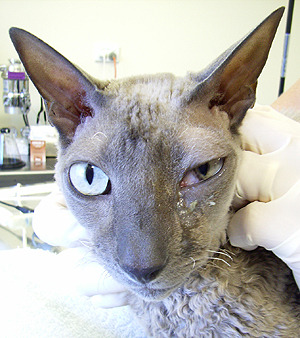New species of fungus found
A University of Sydney researcher has discovered a new species of fungus that causes life-threatening infections in humans and cats. Her work has been published in the online journal PLOS One.
Dr Vanessa Barrs, from the university’s Faculty of Veterinary Science, explained that in 2006 she spotted “an unusual infection in three cats I was seeing at the university’s cat treatment centre”.
“These cats presented with a tumour-like growth in one of their eye sockets that had spread there from the nasal cavity. The fungal spores are inhaled and in susceptible cats they establish a life-threatening infection that is very difficult to treat.”

Dr Barrs and her team investigated the fungus over the next six years, at one point working with some of the world’s leading fungal experts at the CBS-KNAW Fungal Biodiversity Centre in the Netherlands.
She identified it as a new species, Aspergillus felis, which can cause virulent disease in humans and cats by infecting their respiratory tract. A variety of tests and observations were then conducted to confirm her hypothesis.
Like the related fungus Aspergillus fumigates - “a well-studied cause of disease in humans,” according to Dr Barrs - the new species of fungus can reproduce both asexually and sexually. Unlike A. fumigatus, however, it was unable to grow at 50°C. It was also demonstrated to be “intrinsically more resistant to antifungal drugs,” she said.
It was also shown to be different from the similar fungus A. viridinutans by its ability to grow at 45°C. The researchers believe the “analysis of other clinical isolates identified worldwide as A. viridinutans would reveal more strains of A. felis.”
Since the first sighting of the species, the fungus has been identified in more than 20 domestic cats around Australia (and one from the UK), two humans, one dog and an indoor air sample in Germany. It has proved fatal to the humans (who already had highly compromised immune systems) and the survival rate for cats is only 15%.
The German air sample indicates that the species is “distributed by airborne propagules”, according to the researchers, but it is apparently not passed between humans and cats. However, its study in cats will help with treatment and providing a good model for its study in people.
The next step for Dr Barrs and her team is studying fungi in culture collections throughout Australia to determine the prevalence of A. felis infections in people with previously diagnosed aspergillosis. They will collaborate with researchers at the Westmead Millennium Institute for Medical Research.
They are also keen to determine the geographical distribution and prevalence of the species as an emerging fungal pathogen.
Blood test could be used to diagnose Parkinson's earlier
Researchers have developed a new method that requires only a blood draw, offering a non-invasive...
Cord blood test could predict a baby's risk of type 2 diabetes
By analysing the DNA in cord blood from babies born to mothers with gestational diabetes,...
DNA analysis device built with a basic 3D printer
The Do-It-Yourself Nucleic Acid Fluorometer, or DIYNAFLUOR, is a portable device that measures...





